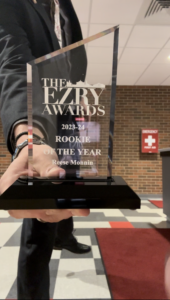When high school students start their college search, one of the first places they go is the Internet. Websites such as The Princeton Review, US News and World Report, College Prowler, and others give a curious perspective student an abundance of information. But what if this online information is inconsistent or misrepresentative of the school? Students who search Wittenberg online may expect some of this confusion, particularly concerning acceptance rate data.
A school’s acceptance rate refers to how many students were accepted out of a total number of students who applied. This statistic can be very important to students involved in their college search. It can represent the exclusivity of the school, a quality some prospective students find attractive. “I think it represents a certain amount of standards that an institution upholds,” said junior Maddie Law in regards to a school’s acceptance rate. “In the grand scheme of things, it’s encouraging to me to see a school doesn’t let in just anyone from a lower acceptance rate.”
According to popular website collegeprowler.com, prospective students may discover that Wittenberg accepts 67 percent of people who apply. Students might also try US News and the Princeton Review, both of which say Wittenberg accepts 91 percent of all applications. Another common website is petersons.com which reports Wittenberg’s acceptance rate as 84 percent. Collegeview.com reports that Wittenberg extends acceptance to 73 percent of all applications it receives.
However, this discrepancy in information is not a factor in another nearby universities presented online data. Although we do not have KenyonCollege’s official admissions information regarding acceptance rate, all five of the mentioned websites had their schools acceptance rate reported at 36 percent (+/- 3 percent). Although this information is not perfectly consistent, there is much less discrepancy in Kenyon’s data than with Wittenberg.
Professor of Economics and the head of the Association of Institutional Research (AIR) Jeff Ankrom is also a member of the Higher Education Data Sharing (HEDS) consortium. Both of these groups are designed to publicize data to these websites, as well as critique them.
When asked what Wittenberg’s official acceptance rate is, Ankrom reported that Wittenberg’s acceptance rate for the class of 2017 is at 89.4 percent. This number is down from the class of 2016’s acceptance rate which was at 91.2. Wittenberg’s most recent graduating class, the class of 2013, posted an acceptance rate of 68.8 percent.
According to Ankrom, the AIR and the HEDS both post their data to the Integrated Postsecondary Education Data System or IPEDS as well as other data bases such as Common Data Set (CDS) and Fact Book (FB). In regards to how these websites find college acceptance rates to post on the pages, Dr. Ankrom said, “I cannot control what some of these outfits do. Some of them pull data from IPEDS, some pull from the CDS and the FB. Some of them re-cook our data or assemble it incorrectly. It would be a big job for me to watchdog them all.”
According to Ankrom, Wittenberg attempts to address these online discrepancies. “We do it when they let us correct data before they go to press,” said Anrkom. “And we have proactively fixed big errors before they go to press. Some will not even give you a chance.”
Ankrom addressed the problem of so many websites reporting so much data, and the appearance of inconsistencies. Of the websites he said, “Some respond and some appear not to care if there are obvious methodological problems.”
Despite the challenges of maintaining accurate acceptance rate information in the various college databases as well as dealing with the array of information any perspective can get from an online source, some Wittenberg professors believe the school is doing an excellent job of navigating through the confusion.
“I certainly believe that what we report to external bodies is very carefully reviewed, very carefully thought about.” said Michael Anes, professor of psychology. “Several institutions in the past have been caught fabricating their data – a simple Google search will reveal some even this year – so the negative consequences of even thinking of going down that road are far too severe for Wittenberg to contemplate.”





